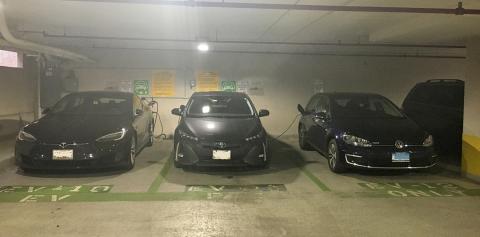Electric Vehicle Charging at NIH

Photo: Jaroslav Sebek
The composition of vehicles at NIH, both employee and fleet, is transitioning to include more hybrid and electric vehicles (EV). NIH is committed to support this transition to reduce greenhouse gas (GHG) emissions and associated health effects.
To address the increasing demand, NIH is working to add new charging stations at each of its owned campuses and leased facilities. The number of charging stations for fleet vehicles is growing relative to the increase in electric fleet vehicles. Installing charging stations for employee vehicles is complex due to federal requirements. Below is a summary of the NIH EV charging program, EV charging requirements and restrictions to charging employee vehicles at NIH.
Elements of Transition
Executive order (EO) 14008 and EO 14057 require federal agencies to transition to a zero-emission vehicle (ZEV) fleet to reduce GHG emissions. The General Services Administration (GSA) defines ZEV as battery electric vehicles, plug-in hybrid-electric vehicles (PHEV) and fuel cell electric vehicles that are powered by hydrogen.
For details on GAO definitions, go to https://bit.ly/49Y7hZa.
The transition to ZEV is to be accomplished through new vehicle acquisitions with acquisition targets by vehicle class.
For all new light-duty vehicle acquisitions, agencies are to purchase 100% ZEV by 2027. NIH has exceeded all ZEV acquisition targets and continues to add fleet charging stations.
In 2024, NIH will add new charging stations for fleet vehicles at the Lot 34 fuel station in Bethesda and Bldg. 101 in Research Triangle Park, N.C. NIH will continue to expand fleet charging stations to meet the growing need.
Government vs. Personal Vehicles
While the government has taken a strong stance to require additional charging stations for fleet vehicles, there are no federal requirements to install charging stations for employee vehicles.
Agencies are asked to consider employee EV charging as part of a comprehensive ZEV plan, however installing and operating EV charging stations at federal facilities for employee-owned vehicles is regulated by the Fixing America’s Surface Transportation (FAST) Act.
The FAST Act requires the government to recover all costs from employee charging. To meet these requirements, agencies must track all costs, collect fees and reimburse the government.
To read FAST Act details, visit https://bit.ly/3vi2imH.
Installing charging stations for fleet vehicles is largely a one-time project. For employees’ personal vehicles, station installation is just the beginning; they require ongoing monitoring that grows as more stations are added.
Meeting the Need
The number of staff and visitors who are using EV and PHEV to commute to NIH campuses continues to increase. NIH recognizes the need and is committed to expanding charging stations for personal vehicles to support that need.
Charging stations will be added as part of construction and renovation projects, and in locations that don’t require extensive infrastructure upgrades.
There are plans to install infrastructure to support employee EV charging at each of the NIH-owned campuses: Multi-level parking lot (MLP)-12 in Bethesda, Md.; Bldg. 102 in Poolesville, Md.; Bldg. 101 in Research Triangle Park, N.C.; and Bldg. J at Rocky Mountain Laboratories, Mont.
In addition to owned properties, NIH is working to include EV charging options at leased facilities; several already have stations available to NIH’ers. Expansion of EV charging for personal vehicles will continue, however careful planning is required to enable cost reimbursement in accordance with the FAST Act.
Where Can Staff Get Charged?
Currently, there are eight outlets and 13 parking spots on the Bethesda campus designated for employee EV charging. These clearly marked stations are located in MLP-6, MLP-7 and Bldg. 10 Ambulatory Care Research Facility P2 and P3 levels. These are the only outlets available to staff for charging personal EV and PHEV.
The NIH Federal Credit Union sponsors the stations and reimburses the cost in accordance with the FAST Act. The outlets are on a dedicated circuit and were set up for EV and PHEV charging.
Read details on the stations at https://go.nih.gov/WTbaGFJ.
Stay tuned for updates on new employee charging stations. By supporting the transition to ZEV, NIH will reduce GHG, help limit the health impacts of climate change and remain a premiere workplace.
To learn more about the health effects of climate change, visit https://go.nih.gov/9dJ8HwK.
Read the EOs at https://bit.ly/3Tg1Ayu and https://bit.ly/3PlgAtU.

